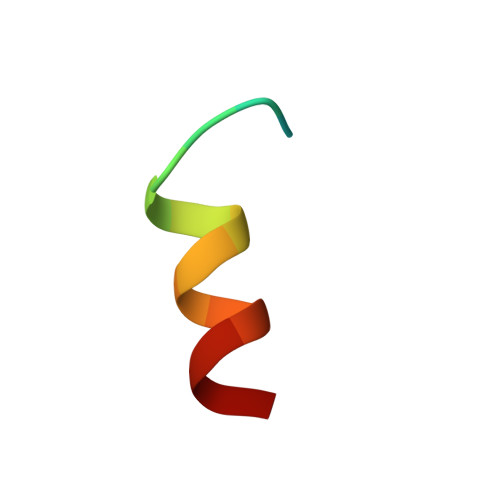Inhibition of the human respiratory syncytial virus small hydrophobic protein and structural variations in a bicelle environment.
Li, Y., To, J., Verdia-Baguena, C., Dossena, S., Surya, W., Huang, M., Paulmichl, M., Liu, D.X., Aguilella, V.M., Torres, J.(2014) J Virol 88: 11899-11914
- PubMed: 25100835
- DOI: https://doi.org/10.1128/JVI.00839-14
- Primary Citation of Related Structures:
2NB7, 2NB8 - PubMed Abstract:
The small hydrophobic (SH) protein is a 64-amino-acid polypeptide encoded by the human respiratory syncytial virus (hRSV). SH protein has a single α-helical transmembrane (TM) domain that forms pentameric ion channels. Herein, we report the first inhibitor of the SH protein channel, pyronin B, and we have mapped its binding site to a conserved surface of the RSV SH pentamer, at the C-terminal end of the transmembrane domain. The validity of the SH protein structural model used has been confirmed by using a bicellar membrane-mimicking environment. However, in bicelles the α-helical stretch of the TM domain extends up to His-51, and by comparison with previous models both His-22 and His-51 adopt an interhelical/lumenal orientation relative to the channel pore. Neither His residue was found to be essential for channel activity although His-51 protonation reduced channel activity at low pH, with His-22 adopting a more structural role. The latter results are in contrast with previous patch clamp data showing channel activation at low pH, which could not be reproduced in the present work. Overall, these results establish a solid ground for future drug development targeting this important viroporin. Importance: The human respiratory syncytial virus (hRSV) is responsible for 64 million reported cases of infection and 160,000 deaths each year. Lack of adequate antivirals fuels the search for new targets for treatment. The small hydrophobic (SH) protein is a 64-amino-acid polypeptide encoded by hRSV and other paramyxoviruses, and its absence leads to viral attenuation in vivo and early apoptosis in infected cells. SH protein forms pentameric ion channels that may constitute novel drug targets, but no inhibitor for this channel activity has been reported so far. A small-molecule inhibitor, pyronin B, can reduce SH channel activity, and its likely binding site on the SH protein channel has been identified. Black lipid membrane (BLM) experiments confirm that protonation of both histidine residues reduces stability and channel activity. These results contrast with previous patch clamp data that showed low-pH activation, which we have not been able to reproduce.
Organizational Affiliation:
School of Biological Sciences, Nanyang Technological University, Singapore.














